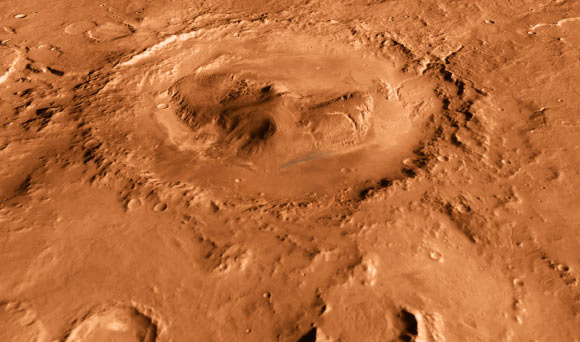In a paper published in the journal Physical Review E, a duo of fluid dynamics experts proposes a solution to one of long-standing Martian mysteries. The research shows that wind vortices can produce the common Martian phenomenon of a stratified mound positioned downwind from the center of an ancient meteorite impact zone.

Gale Crater is 96 miles (154 km) in diameter and holds a layered mountain rising about 3 miles (5 km) above the crater floor. Image credit: NASA / JPL-Caltech / ASU / UA.
Mars’ Gale Crater, the site being explored by NASA’s Curiosity rover, was formed by meteorite impact early in the history of the planet, and it was subsequently filled with sediments transported by flowing water.
This filling preceded massive climate change on Mars, which introduced the arid, dusty conditions that have been prevalent for the past 3.5 billion years. This chronology indicates wind must have played a role in sculpting the mountain.
“On Mars, wind has been the only driver of landscape change for over 3 billion years,” said Dr. William Anderson, a researcher at the University of Texas at Dallas.
“This makes Mars an ideal planetary laboratory for aeolian morphodynamics — wind-driven movement of sediment and dust. We’re studying how Mars’ swirling atmosphere sculpted its surface.”
Wind vortices blowing across Gale Crater slowly formed a radial moat in the sediment, eventually leaving only the off-center Mount Sharp, a 3-mile-high peak similar in height to the rim of the crater.
The mountain was skewed to one side of the crater because the wind excavated one side faster than the other, according to the team.
Dr. Anderson and his colleague, University of Washington researcher Dr. Mackenzie Day, first advanced the concept in an initial publication on the topic in the journal Geophysical Research Letters.
Now, they have shown via computer simulation that, given more than a billion years, Martian winds were capable of digging up tens of thousands of cubic km of sediment from the crater — largely thanks to turbulence, the swirling motion within the wind stream.
“The role of turbulence cannot be overstated. Since sediment movement increases non-linearly with drag imposed by the aloft winds, turbulent gusts literally amplify sediment erosion and transport,” Dr. Anderson said.
The theory the scientists tested via computer simulations involves counter-rotating vortices — picture in your mind horizontal dust devils — spiraling around the crater to dig up sediment that had filled the crater in a warmer era, when water flowed on Mars.
“These helical spirals are driven by winds in the crater, and, we think, were foremost in churning away at the dry Martian landscape and gradually scooping sediment from within the craters, leaving behind these off-center mounds,” Dr. Anderson said.
The simulations have demonstrated that wind erosion could explain these geographical features.
“It’s further indication that turbulent winds in the atmosphere could have excavated sediment from the craters,” Dr. Anderson said.
“The results also provide guidance on how long different surface samples have been exposed to Mars’ thin, dry atmosphere.”
“This understanding of the long-term power of wind can be applied to Earth as well, although there are more variables on our home planet than Mars,” he said.
“Swirling, gusty winds in Earth’s atmosphere affect problems at the nexus of landscape degradation, food security and epidemiological factors affecting human health. On Earth, however, landscape changes are also driven by water and plate tectonics, which are now absent on Mars. These drivers of landscape change generally dwarf the influence of air on Earth.”
_____
William Anderson & Mackenzie Day. 2017. Turbulent flow over craters on Mars: Vorticity dynamics reveal aeolian excavation mechanism. Phys. Rev. E 96 (4): 043110; doi: 10.1103/PhysRevE.96.043110







